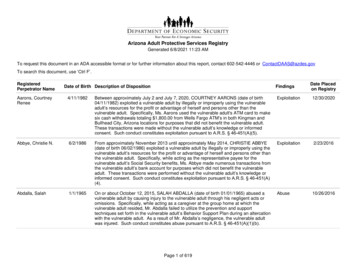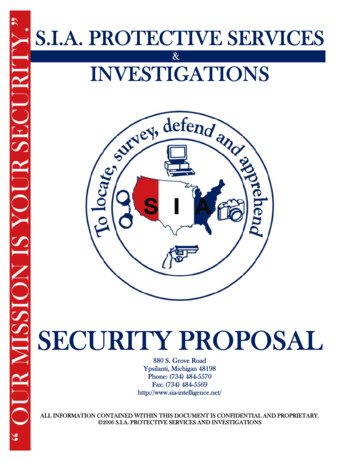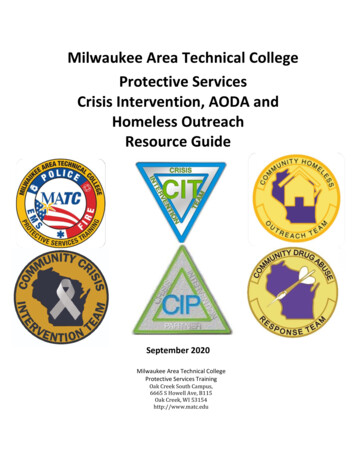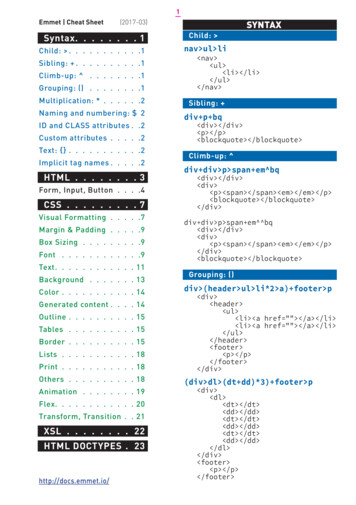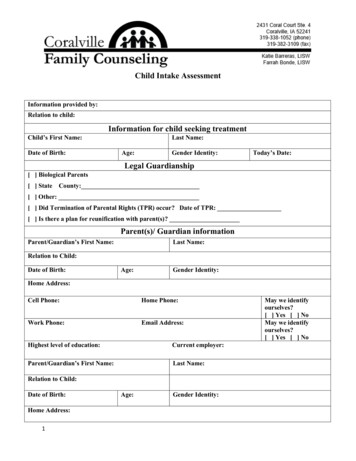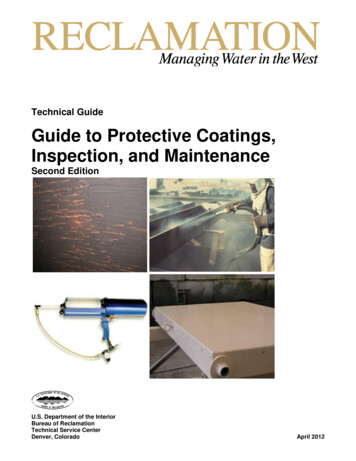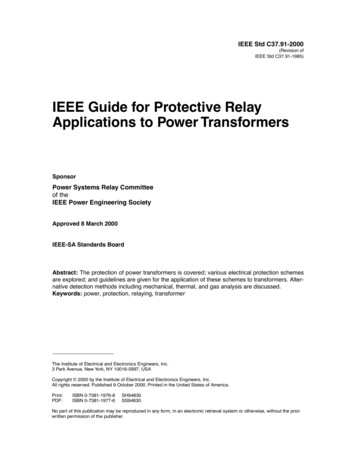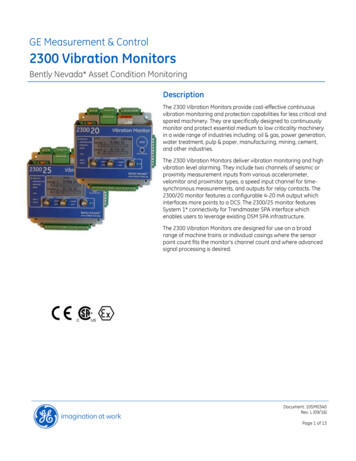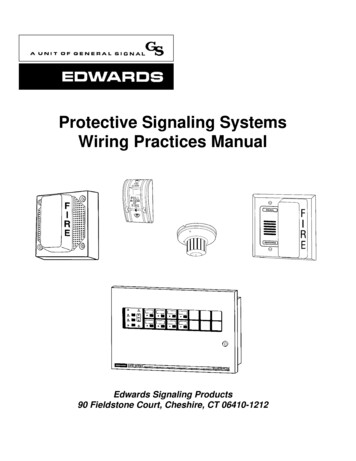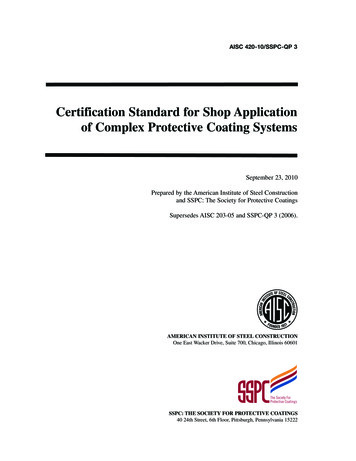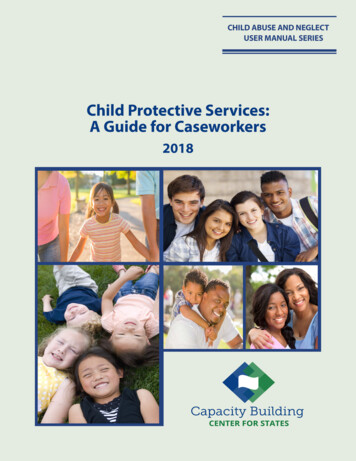
Transcription
CHILD ABUSE AND NEGLECTUSER MANUAL SERIESChild Protective Services:A Guide for Caseworkers2018
Child Protective Services:A Guide for CaseworkersDiane DePanfilis, Ph.D., M.S.W.2018U.S. Department of Health and Human ServicesAdministration for Children and FamiliesAdministration on Children, Youth and FamiliesChildren’s BureauOffice on Child Abuse and Neglect
Table of ContentsPREFACE . 6ACKNOWLEDGMENTS . 8Acknowledgments . . 8Principal Reviewers . 8Reviewers . . 9Other Acknowledgments . 9CHAPTER 1: PURPOSE AND OVERVIEW . . 101.1 Background . . 101.2 Terms and Definitions . .111.3 Topics Addressed in This Manual . 12CHAPTER 2: CHILD PROTECTIVE SERVICES PRACTICE .132.1 National Goals for Child Protection . 152.2 Philosophical Tenets of Child Protective Services . 152.3 Framework for Practice . 172.4 Caseworker Competence . 192.5 Stages of CPS . . 19CHAPTER 3: LEGAL CONTEXT OF CPS INTERVENTION . 243.1 Federal Role . 243.2 Basis for State and Tribal Intervention . 303.3 Child Maltreatment Definitions . 31CHAPTER 4: ENGAGING AND WORKING WITH CHILDREN AND FAMILIES . 354.1 Engaging Diversity and Difference With Cultural Sensitivity . . 354.2 Core Conditions of Helping Relationships . 374.3 Building Rapport and Engaging Families . . 404.4 Use of Authority in Child Protective Services . 434.5 Culturally Competent CPS Intervention . 45CHAPTER 5: REPORTING AND INTAKE . 485.1 Community Outreach and Education . 485.2 Reporting Child Abuse and Neglect . 495.3 CPS Intake . 54CHAPTER 6: INITIAL ASSESSMENT OR INVESTIGATION . . 646.1 Initial Assessment Process . 656.2 Analysis of Information at Decision Points . 79CHAPTER 7: COMPREHENSIVE FAMILY ASSESSMENT . 997.1 Principles for Conducting Family Assessments . . 997.2 Family Assessment Process . 101
CHAPTER 8: DEVELOPMENT OF THE FAMILY PLAN .1128.1 Family Plan Decisions .1138.2 Involving the Family in the Planning Process .1138.3 Targeting Outcomes in the Family Plan . .1158.4 Determining Goals to Accomplish Outcomes .1188.5 Determining Action Steps to Achieve Goals . . 120CHAPTER 9: CHANGE STRATEGIES AND INTERVENTIONS .1239.1 Defining Terms to Guide the Selection of Change Strategies . .1249.2 Matching Change Strategies and Interventions to Outcomes . 1269.3 Collaborating With Community Partners . 128CHAPTER 10: EVALUATION OF CHANGE .13010.1 Evaluating Change on a Regular Basis . . 13010.2 Evaluating the Change Process . . 13210.3 Considering Areas of Assessment and Key Decisions . 13210.4 Linking the Evaluation of Change to Other Reviews . 135CHAPTER 11: CLOSURE AND ENDING CPS INVOLVEMENT . .13611.1 Types of CPS Closure . 13611.2 The Process of Ending CPS Involvement . 13711.3 Community Collaboration During Closure . 139CHAPTER 12: EFFECTIVE DOCUMENTATION . 14012.1 Purposes of Child Protective Services Recordkeeping . . 14012.2 Principles of Effective Documentation .14112.3 Using Behavioral Descriptors . . 14212.4 Content of Child Protective Services Records . 143CHAPTER 13: SUPERVISION . . 14513.1 Consultative Supervisory Practices . 14613.2 Coaching Supervisory Practices . 14813.3 Supervisory Consultation and Coaching on Key CPS Decisions . 156CHAPTER 14: CASEWORKER WELLNESS AND SAFETY .16214.1 Caseworker Wellness . 16214.2 Caseworker Safety . 166REFERENCES . .169APPENDIX A: GLOSSARY .191APPENDIX B: RESOURCE LISTINGS OF SELECTED ORGANIZATIONS CONCERNEDWITH CHILD MALTREATMENT .199APPENDIX C: STATE DIRECTORY OF WHERE TO REPORT SUSPECTED CHILDMALTREATMENT . 200APPENDIX D: EXAMPLES OF CPS CORE COMPETENCIES . . 204APPENDIX E: MAJOR PROVISIONS OF THE CHILD ABUSE PREVENTION ANDTREATMENT ACT (CAPTA) REAUTHORIZATION ACT OF 2010 . . 207
APPENDIX F: CONTENT OF AN INTAKE REPORT .212APPENDIX G: ASSESSMENT INSTRUMENTS .214APPENDIX H: EXAMPLES OF CHANGE STRATEGIES AND OUTCOMES . 230APPENDIX I: CHAPTER 10 – ALTERNATIVE CASE SCENARIOS FOR THESMITH FAMILY .247S
PrefaceEach day, the safety and well-being ofchildren across the nation are threatened bychild abuse and neglect. Intervening effectivelyin the lives of these children and their familiesdoes not rest with any single agency orprofessional group but rather is a sharedcommunity concern.The Child Abuse and Neglect User ManualSeries has provided guidance on childprotection to hundreds of thousands ofmultidisciplinary professionals and concernedcommunity members since the late 1970s. Theseries provides a foundation for understandingchild maltreatment and the roles andresponsibilities of various practitioners inits prevention, identification, investigation,assessment, and treatment. Through theyears, the manuals have served as valuableresources for building knowledge, promotingeffective practices, and enhancing communitycollaboration. It is the hope that these updatedmanuals continue that tradition.the Children’s Bureau of the Administrationfor Children and Families, U.S. Department ofHealth and Human Services, has developed thefourth edition of this manual in the User ManualSeries to reflect the increased knowledgebase and the evolving state of practice. ChildProtective Services: A Guide for Caseworkersprovides a comprehensive view of the childwelfare process. This manual examines theroles and responsibilities of child protectiveservices (CPS) workers, who are at the centerof every community’s child protection efforts.It describes the laws and policies that governchild protection, the basic stages of the CPSprocess and the steps necessary to accomplisheach stage, and the importance of supervisionand worker safety and wellness.Since the last update of the User Manual Seriesin the early 2000s, the changing landscapereflects increased recognition of the complexityof issues facing parents and their children,new legislation, practice innovations, andsystem reform efforts. Advances in researchand evidence-based practice have helpedshape new directions for interventions. TheOffice on Child Abuse and Neglect, within6Child Protective Services: A Guide for Caseworkers
Best practices and critical issues in caseworkpractice are underscored throughout. Theprimary audience includes CPS caseworkers,supervisors, and administrators. State, tribal,and local CPS agency trainers may use themanual for pre- or inservice training of CPScaseworkers, while schools of social work mayadd it to class reading lists to orient studentsto the field of child protection. In addition,other professionals and concerned communitymembers may consult the manual for a greaterunderstanding of the child protection process.Another manual, Child Protection in FamiliesExperiencing Domestic Violence, serves as acompanion piece by looking at the CPS processthrough a domestic-violence lens.Child Protective Services: A Guide forCaseworkers, Child Protection in FamiliesExperiencing Domestic Violence, andprior versions of the entire User ManualSeries, are available at ld Protective Services: A Guide for Caseworkers7
Acknowledgments8AuthorAcknowledgment of Prior EditionsDiane DePanfilis, Ph.D., M.S.W., is Professor ofSocial Work at the Silberman School of SocialWork, Hunter College, City University of NewYork. She has over 40 years of experiencein the child welfare field as a caseworker,supervisor, director, trainer, evaluator, educator,and researcher and has published extensivelyon child maltreatment and child protectionissues. She has led the design, testing,and implementation of federally funded,community-based interventions focusedon preventing child maltreatment and onsupporting systems to use evidence and datato inform decision-making related to policy,program, and practice reforms. Dr. DePanfilisis a former Vice President of the Society forSocial Work and Research and former Presidentof the American Professional Society on theAbuse of Children. She has received numerousawards and honors including appointment as afellow of the American Academy of Social Workand Social Welfare and the Society for SocialWork and Research; a University of MarylandBaltimore Champion of Excellence andFounders Research Lecturer of the Year; andthe Aaron Rosen Lecturer by the Brown Schoolof Social Work and the Society for Social Workand Research.This manual is an update of two prior versionsof this manual, written by Diane DePanfilis andMarsha K. Salus in 1992 and 2003. The firstedition of the manual was published in 1980 asChild Protection: Providing Ongoing Servicesby Cynthia K. Ragan, Marsha K. Salus, andGretchen L. Schultze.AcknowledgmentsStaff from the Capacity Building Center forStates and the Child Welfare InformationGateway conducted some of the search forupdated literature. In particular, Debra Gilmore,M.P.A., J.D., conducted most of the researchrelated to change strategies and interventionsincluded in chapter 9. In addition, JeannieNewman, M.S.W., M.I.B.S., provided someadditional content, reviewed, and edited.Principal ReviewersThese individuals provided extensive reviewand feedback:Debra Gilmore, M.P.A., J.D.Research StrategistCapacity Building Center for StatesChild Protective Services: A Guide for Caseworkers
Kathy Simms, M.S.W.Program Area Advisor,Protective Services & In-Home ServicesCapacity Building Center for StatesEileen WestSenior Program SpecialistAdministration for Children and Families,Children’s BureauQuincy Wilkins, M.S., L.M.F.T., L.P.C.C.Program Area Manager, Child ProtectionServicesCapacity Building Center for StatesOther AcknowledgmentsReviewersThe following individuals also reviewed draftsand provided valuable feedback:This user manual was developed under thedirection and guidance of Jean Blankenship,Federal Program Officer; Julie Fliss, FederalChild Welfare Program Specialist; and ElaineStedt, Director, Office on Child Abuse andNeglect.Gloria Carroll, M.S.W., L.C.S.W.Program Area Manager, In-Home/FamilyPreservation ServicesCapacity Building Center for StatesSuzan CohenStaff ParalegalChild Welfare Information GatewayTheresa CostelloExecutive DirectorAction for Child ProtectionMark Ells, J.D., L.L.M.Research Assistant ProfessorCenter on Children, Families and the Law,University of Nebraska-LincolnJohn D. Fluke, Ph.D.Associate Director for Systems Research andEvaluation, Research ProfessorDepartment of Pediatrics, Kempe Center forthe Prevention and Treatment of ChildAbuse & Neglect, University of ColoradoSchool of MedicineResearch ProfessorDepartment of Epidemiology, Colorado Schoolof Public Health, University of Colorado-DenverMatthew Shuman, M.S.W.Senior Writer/EditorChild Welfare Information GatewayChild Protective Services: A Guide for Caseworkers9
Chapter 6:Child Protective ServicesChapterProcess:1:Intake, InitialAssessment/Investigation,Purpose and Overviewand Safety Assessmentand PlanningThis manual, Child Protective Services:A Guide for Caseworkers, provides thefundamental information that child protectiveservices (CPS) professionals need to know toperform essential casework functions. This firstchapter: Provides the context for the manualDefines basic terms, used in general andthroughout the manual, for describing theCPS process and activitiesLays out the sequencing of the chapters,each of which builds upon previouschapters, for ease of reference1.1 BackgroundFor federal fiscal year 2016, the Children’sBureau (2018) found that the United Stateshad approximately 676,000 reported victimsof child abuse and neglect, or 9.1 victimsper 1,000 children in the population. Toprotect children from harm, CPS relies oncommunity members to identify and reportsuspected cases of child maltreatment,including physical abuse, sexual abuse,neglect, and psychological maltreatment. Manyprofessionals (including health care providers,mental health professionals, educators, andlegal and court system personnel) are involvedin responding to cases of child maltreatmentand in providing needed services.Because child abuse and neglect is acommunity concern, each community hasa legal and moral obligation to promotethe safety, permanency, and well-being1 ofchildren, which includes responding effectivelyto reports of child maltreatment. At thefederal level, the Child and Family ServicesReviews (CFSRs) monitor states to measuretheir effectiveness at achieving these goals. Atthe state, tribal, and local levels, professionalsassume numerous roles and responsibilities(ranging from prevention, identification andreporting of child maltreatment to assessment,intervention, and treatment) to achieve thosegoals.CPS, a division within state, tribal, and localsocial services, is at the center of everycommunity’s child protection efforts. CPSagencies, along with law enforcement, playa central role in receiving and investigatingreports of child maltreatment. The focus of CPSagencies is to determine if a child is safe andwhether there is risk of future maltreatment.They also offer services to families and childrenwhere maltreatment has occurred or is likely tooccur.The focus of the CPS process is on safety. Permanency and wellbeing are the purview of other areas of the child welfare system andare beyond the scope of this manual.110Child Protective Services: A Guide for Caseworkers
Child and Family ServicesReviewsThe CFSRs enable the Children’s Bureau,Administration for Children and Families,U.S. Department of Health and HumanServices, to (1) ensure conformity withfederal child welfare requirements; (2)determine what is actually happening tochildren and families engaged in childwelfare services; and (3) assist states inenhancing their capacity to help childrenand families achieve positive outcomes.The Children’s Bureau completed thefirst round of the CFSRs in 2004 (afterthe publication of the third edition of thismanual) and currently is conducting thethird round. The CFSRs evaluate publicchild welfare systems to determine howwell they achieve safety, permanency, andwell-being in difficult situations of childmaltreatment (U.S. Department of Healthand Human Services, Children’s Bureau,n.d.). They also help states developeffective Program Improvement Plans toimprove child and family outcomes andto enhance collaboration with serviceproviders. For more information on theCFSRs, visit -services-reviews(para.1).as “change strategies and interventions.” Thisphrase more accurately captures a paradigmshift. Now the caseworker’s goal focusesmore on matching change strategies andinterventions to family strengths and needs toachieve specific outcomes, rather than merelyproviding services or requiring attendance inprograms that may or may not be beneficialto achieving those outcomes. The Overview ofChild Protection Process in chapter 2,
Child Protective Services: A Guide for Caseworkers. Diane DePanfilis, Ph.D., M.S.W. 2018. U.S. Department of He
